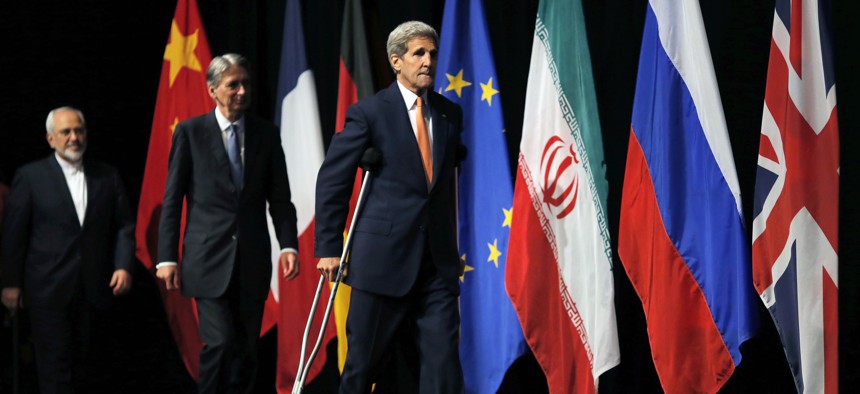
U.S. Secretary of State John Kerry, centre British Foreign Secretary Philip Hammond, centre and Iranian Foreign Minister Mohammad Javad Zarif arrive for a group picture at the Vienna International Center in Vienna, Austria, Tuesday, July 14, 2015. Carlos Barria/AP
A Good Iran Deal
To understand just how important the Iran agreement is, let’s compare life with the deal to life without it.
Good Iran deals come to those who wait. After years of effort, endless plot twists, and highly charged political drama, the United States and its partners have reached a final deal with Iran to shackle its nuclear program in exchange for sanctions relief. It’s a good deal that Congress should support.
This deal, like all agreements, is not perfect and will not please everyone. Those running for president and others who want to score political points against President Barack Obama will find reasons to criticize it. Opponents will make a lot of noise, but ultimately they offer no viable alternatives.
Now that the deal is done, the debate has entered a new phase. In the next few days the Obama administration will send the final text to Congress for a 60-day review. But the time for “fixing” the agreement is over. The deal is the deal—take it or leave it.
At this point, there is only one real question for Congress and the American public to ask: Is the United States better off with this deal, or without it?
Unlike “Let’s Make a Deal,” there is no Door No. 2. There is no other deal.
As the details of the agreement show, the United States is much better off with this deal and Congress should support it on that basis. Simply put, the deal prevents an Iranian nuclear bomb without endangering U.S. troops or inflaming wider regional conflict. But without this deal, Iran could resume and accelerate its nuclear program, increasing the chances of an Iranian nuclear bomb and U.S. military action.
To understand just how important the Iran agreement is, let’s compare life with the deal to life without it.
Without a deal: If Senate Republican Majority Leader Mitch McConnell’s recent call for Obama to “pause” talks on a “bad” deal is any indication, the GOP-controlled Congress is heading toward blocking the agreement. This would be a tragic mistake.
Without the deal, Iran would keep its 19,000 centrifuges and large uranium stockpile and be able to produce enough highly enriched uranium for a single bomb in two to three months, should it decide to do so. (It would take another year or so to produce an actual bomb.) But this 2- to 3-month “breakout” period is perilously short, raising tensions in the region.
Without the deal, Congress is likely to impose new economic sanctions on Iran, and Tehran is likely to accelerate uranium enrichment at its underground Fordow facility, reducing the breakout time even more. Iran would also resume construction of its nearly complete Arak reactor to produce plutonium, another bomb ingredient. Iran may also kick out international inspectors, significantly reducing the United States’ ability to see inside Iran’s nuclear program, and increasing worst-case assumptions.
This dangerous combination of shorter breakout times and less transparency would increase pressure on the United States to use military force as the only way to stop Iran from building a nuclear bomb. But a U.S. military strike would only delay Iran’s efforts by a few years while igniting a firestorm in an already-volatile Middle East.
With a deal: To avoid such a grim scenario, there is the agreement negotiated by the United States, Russia, China, Great Britain, France and Germany. It will defuse this untenable situation and dramatically increase the chances for a peaceful solution.
The deal shrinks and freezes Iran’s program. Instead of two to three months, Iran’s breakout time will be extended to a full year, which is enough time to detect and disrupt any effort by Tehran to dash to a bomb.
The 12-month breakout time is achieved by limiting enrichment to less than 5 percent, reducing Tehran’s installed centrifuges by two-thirds (from 19,000 to about 6,000), limiting research, and by reducing its uranium stockpile by 98 percent. These constraints will last for 10 years or more, preventing a bomb far longer than military action could.
In addition, the underground Fordow plant will not enrich uranium for 15 years and Iran’s Arak reactor will be modified to produce much less plutonium. What plutonium is produced will be shipped out of the country, not separated from the reactor fuel.
Nor is the deal built on trust, but on intrusive verification. If Iran cheats, the United States will know. Tehran has agreed to the most robust inspection regime ever negotiated. The International Atomic Energy Agency (IAEA) will have access to all nuclear facilities, Iran’s supply chain, and uranium mines and mills. Tehran has agreed to implement the Additional Protocol, providing for managed access to both declared and undeclared facilities, indefinitely, including covert sites anywhere in the country. Finally, a key concern of critics, Iran has agreed to address the IAEA’s concerns about its past nuclear activities, known as “possible military dimensions.”
On virtually every area where critics have questions, the final deal has answers.
The United States and its partners have delivered a good deal that is a historic win for global security. Congress should support it. If Republicans cannot go that far, there is another option—do not vote. Congress does not have to approve this deal for it to go into effect. In this case, silence is golden.
It’s time for Congress to rise above partisan politics and act in the best interests of the United States and the world. We have an historic opportunity to verifiably and peacefully prevent an Iranian nuclear bomb. Let’s take it.
